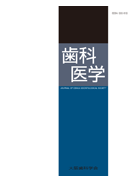Volume 53, Issue 5
Displaying 1-15 of 15 articles from this issue
- |<
- <
- 1
- >
- >|
-
Article type: Article
1990 Volume 53 Issue 5 Pages 403-416
Published: October 25, 1990
Released on J-STAGE: February 20, 2017
Download PDF (1615K) -
Article type: Article
1990 Volume 53 Issue 5 Pages 417-428
Published: October 25, 1990
Released on J-STAGE: February 20, 2017
Download PDF (1133K) -
Article type: Article
1990 Volume 53 Issue 5 Pages 429-449
Published: October 25, 1990
Released on J-STAGE: February 20, 2017
Download PDF (1612K)
-
Article type: Article
1990 Volume 53 Issue 5 Pages 450-
Published: October 25, 1990
Released on J-STAGE: February 20, 2017
Download PDF (183K) -
Article type: Article
1990 Volume 53 Issue 5 Pages 451-
Published: October 25, 1990
Released on J-STAGE: February 20, 2017
Download PDF (186K) -
Article type: Article
1990 Volume 53 Issue 5 Pages 451-452
Published: October 25, 1990
Released on J-STAGE: February 20, 2017
Download PDF (322K) -
Article type: Article
1990 Volume 53 Issue 5 Pages 452-453
Published: October 25, 1990
Released on J-STAGE: February 20, 2017
Download PDF (247K) -
Article type: Article
1990 Volume 53 Issue 5 Pages 454-
Published: October 25, 1990
Released on J-STAGE: February 20, 2017
Download PDF (185K) -
Article type: Article
1990 Volume 53 Issue 5 Pages 454-455
Published: October 25, 1990
Released on J-STAGE: February 20, 2017
Download PDF (338K) -
Article type: Article
1990 Volume 53 Issue 5 Pages 455-456
Published: October 25, 1990
Released on J-STAGE: February 20, 2017
Download PDF (356K) -
Article type: Article
1990 Volume 53 Issue 5 Pages 456-457
Published: October 25, 1990
Released on J-STAGE: February 20, 2017
Download PDF (341K) -
Article type: Article
1990 Volume 53 Issue 5 Pages 457-458
Published: October 25, 1990
Released on J-STAGE: February 20, 2017
Download PDF (340K) -
Article type: Article
1990 Volume 53 Issue 5 Pages 458-459
Published: October 25, 1990
Released on J-STAGE: February 20, 2017
Download PDF (358K) -
Article type: Article
1990 Volume 53 Issue 5 Pages 459-460
Published: October 25, 1990
Released on J-STAGE: February 20, 2017
Download PDF (292K)
-
Article type: Article
1990 Volume 53 Issue 5 Pages g49-g50
Published: October 25, 1990
Released on J-STAGE: February 20, 2017
Download PDF (243K)
- |<
- <
- 1
- >
- >|
